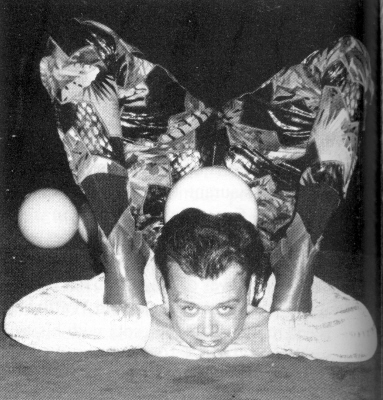
The bendable Boul (Orrel Lanter photo) |
Page 18 Winter 1989 - 90
|
ENTERTAINERS
by
Orrel Lanter
The
brillance of Montreal's
As
a multi-colored fog rolls eerily over and around the single ring of
the blue and yellow big-top, its tendrils tickle a group of "not
so ordinary" townspeople questing for their seats. A Shaharazade
magician crouching high above the ring, flings bolts of lightening
from his fingertips, transforming these mundane folk into performers
for the night. The blustery old man becomes ringmaster, his companions
become clowns, acrobats and high-wire walkers. And, in this age of
heightened animal-rights awareness, there are no animal acts. Instead,
young homo sapiens fill the ring with feats of juggling, balance, and
bicycling that dazzle, delight and transport us into a pageantry
reminiscent of the Middle Ages.
The
elaborate lighting (by Luc Lafortune) and original music (by Rene
Dupere) harmonize perfectly with the sophisticated costumes (by Michel
Crete and Dominique Lemieux) and dramatic choreography (of Debra
Brown) to create theatre at its most spellbinding.
The
Cirque Du Soleil was first unfurled in 1984, the brainchild of Guy
LaLiberte, a fire-breathing, stilt-walking musician with a vision. He
organized the street performers of Canada, convinced the Quebec and
Canadian governments to wisely lend initial support and held a
festival which has now grown into a $15-million a year operation
touring throughout the U.S. and Canada. It has captured corporate
funds as it captivates hearts wherever it goes and has elevated its
performers to the status of "artiste." When the glitterati
and movie stars of L.A. discovered them in
Among
the outstanding international cast is Frederich "Boul"
Zipperlen from France, a creative juggler and contortionist.
He
emerges in the ring from a gigantic cellophane ball and begins a
beguine of dancing, juggling and balancing that dazzles the audience.
He contorts his body into graceful knots while crystal balls fly from
his fingers into the air. One lands on his head and moves smoothly
from forehead to ear, then ear to neck, glides down his arm to the
elbow's bend, then up again to a bicep bump.
Boul
(his nickname in French means... you guessed it, "ball")
specializes in balls. Now he juggles five, and, catching one on his
neck he juggles the rest until they come to a soft landing on his back
and, like neat little soldiers, march down the length of his spine. He
smiles and suddenly three balls move under his leg, merging with two
others into a five ball cascade. Next he does a knee catch and a
forehead balance, his body drops into the splits and twists artfully
into a neck stand with a ball spinning on a finger of each hand.
It
has taken hours of struggle to perfect each move, and there is a quiet
Contortions
now begin in earnest. With one ball held tightly between his feet he
vaults into a handstand, his feet dip in a gradual arch to his head.
The ball drops to his neck while his body lowers to a resting place,
chest on the ground. The crowd is suitably impressed, imagining the
hours of work involved in mastering these seemingly effortless
maneuvers.
He
springs to his feet and, grabbing a handful of ping -pong balls, pops
them into his mouth and blows them out and up into one waiting hand.
The two left in his mouth are blown alternately, from side to side,
into the air to be caught in his mouth again. A
court jester moves behind him holding a hat. Boul bends backward from
the waist and shoots five ping-pong balls, rapid fire, in an arc. They
plop safely one after the other into the waiting bowler. It's his
favorite trick.
Classically,
Zipperlin began his career by running away from home to join the
circus and become a clown. He taught himself to juggle and in the
beginning it was a mighty struggle. He worked on a three ball cascade,
rings and ping-pong balls, practicing eight hours a day. He trained at
the Fratellini Circus School for five years and, while working for a
diploma in tent construction, he taught himself contortion, acrobatics
and trapeze.
Finding
that he preferred New Wave to the traditional circus atmosphere, he
teamed up with Amelie Demay, who was doing a single balancing act, and
they went to the Montreal Jazz Festival and lived by street
performing. He auditioned and was accepted by the Cirque in 1986 and
toured Canada with them.
After
that year, he went briefly to Boston's Faneuil Hall to street perform.
He enjoyed the intimate contact with
the public and tile chance to improvise. Last year at the
French national circus school in Chalons-sur-Marne, he took a workshop
with Peter Davison of Airjazz. He performed in Italy with Michiel
Hesseling in Circo Mi Amore, and at this year's Festival of the Circus
of Tomorrow he was awarded a bronze medal.
He
has been inspired by many acts. At a workshop in Montreal, Lotte Brunn
advised him to go see Francis Brunn. He arranged a one-day workshop
with Brunn. and to this day Brunn remains his favorite juggler. At
this time in his life, instead of putting energy into technique he is
looking to add more theatrics and comedy to his act
The
rest of the performers in this tiny titan of a little top are equally
as polished and are from among the most talented of their respective
countries.
Amelie
Demay and Eric Varelas perform a difficult hand to hand balancing
routine of astonishing strength and grace. She even carries him,
balanced high on her hands, around the ring.
|

The bendable Boul (Orrel Lanter photo) |